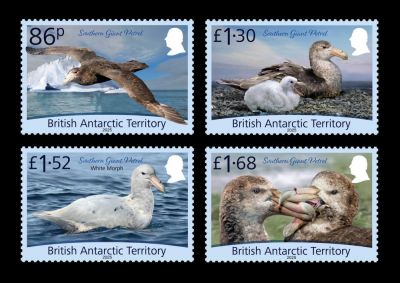
They are large, colonially-nesting seabirds with wingspans of over 2m capable of long-distance ocean travel. The oldest birds can live for more than forty years and most breed for the first time only when they are between six and ten years of age. They produce at most one chick per year. Their breeding season is long; the single egg is incubated for 2 months, and the chick takes a further 3-4 months to fledge. Although the chicks are circumpolar migrants in the first year after fledging, almost all adults remain in the same ocean basin during the nonbreeding season.
The southern giant petrel has a wider breeding distribution than any other Antarctic seabird, from continental Antarctica (68°S) to Patagonia, and as far north as Gough Island in the central South Atlantic (40°S). Although this species has been down-listed to Least Concern by the World Conservation Union (IUCN), there is large annual variation in abundance and variable long-term trends recorded at different sites. Systematic, long-term monitoring helps to understand the population dynamics.
Scientists have studied the giant petrels breeding at Signy Island – in the South Orkney Islands (60°S) – since 1968. Signy Island Research Station is a summer-only station of British Antarctic Survey, where there are also long-term monitoring programmes on a number of species, including penguins (Adélie, chinstrap and gentoo). These surveys, the most detailed on this species in the South Orkneys, revealed that breeding success has declined substantially, from 60% in 1996 to 40% in 2015 in selected study colonies. Whole-island counts show that following an increase in breeding numbers from the mid 1980s to the mid 2000s, the population has halved from over 5800 to around 2600 nesting birds since 2005.
Since the South Orkney Islands, of which Signy is part, represent nearly 10% of the global population of this species, continuation of such a decline both at Signy and elsewhere in this island group would be of high conservation concern.
Considerable variation in breeding pair numbers and breeding success of southern giant petrels has been observed at other islands in the Southern Ocean, and it is clear that this species will defer breeding in years when environmental conditions are poor.
The reasons for the decreases are unknown, but could reflect a reduction in sea ice, penguin abundance or other factors affecting food availability at sea. It is also unclear if the species is declining regionally or more widely. This research highlights the importance of long-term monitoring programmes even for species thought to be doing well. The challenge now is to understand which climatic or other environmental factors are driving these big changes for this important Antarctic predator and scavenger. The long-term monitoring at Signy is funded by the Natural Environment Research Council.
|
Technical Details |
|
|
Designer |
Andrew Robinson |
|
Printer |
Cartor Security Printing |
|
Process |
Lithography |
|
Stamp Size |
42 x 28mm |
|
Perforation |
13 ¼ x 13 ½ per 2cms |
|
Sheet Layout |
10 |
|
Release Date |
Expected Mid November 2025 |
|
Product Co-ordination |
Creative Direction (Worldwide) Ltd |
